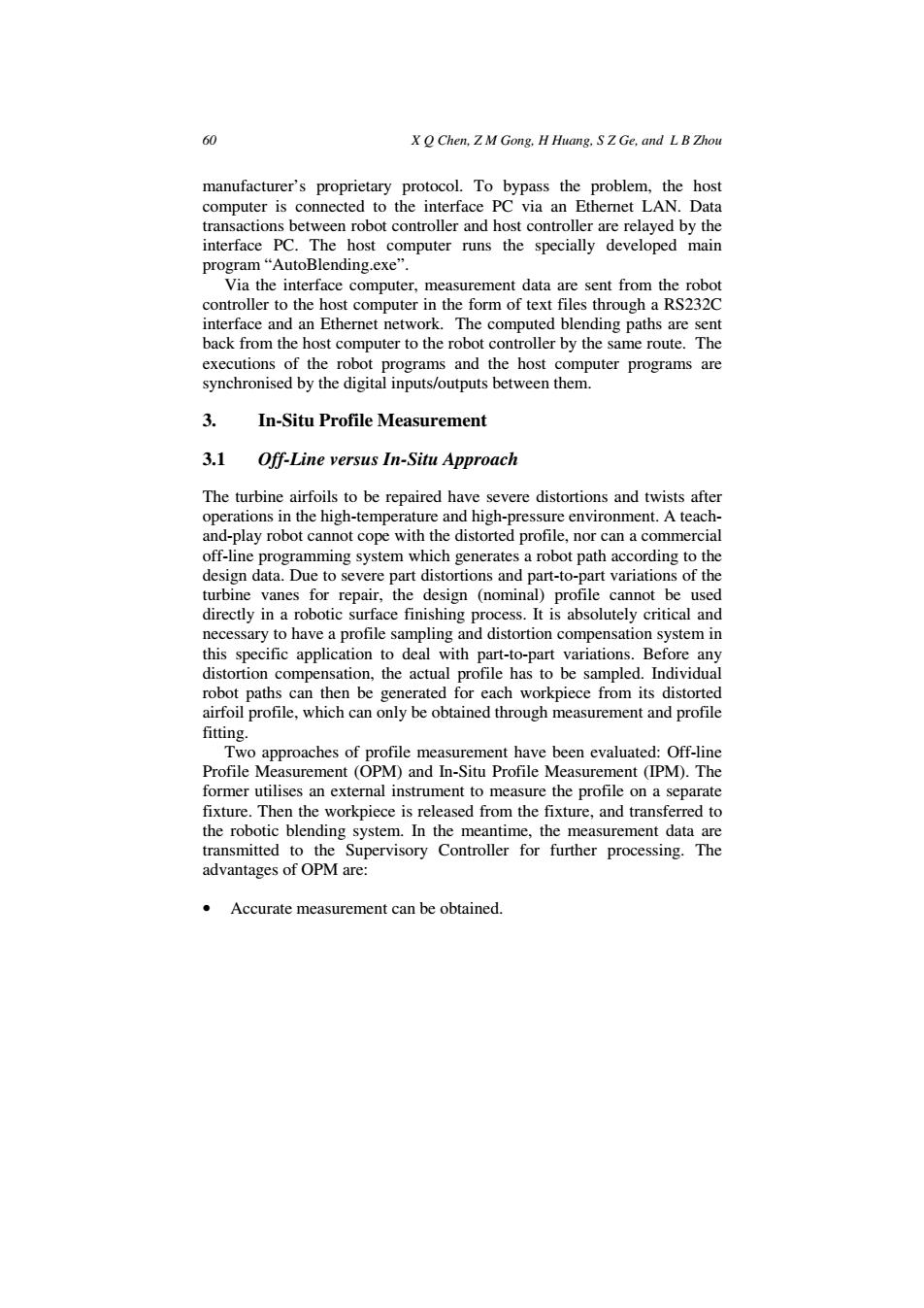正在加载图片...

60 X O Chen,Z M Gong,H Huang.S Z Ge,and L B Zhou manufacturer's proprietary protocol.To bypass the problem,the host computer is connected to the interface PC via an Ethernet LAN.Data transactions between robot controller and host controller are relayed by the interface PC.The host computer runs the specially developed main program“AutoBlending.exe”. Via the interface computer,measurement data are sent from the robot controller to the host computer in the form of text files through a RS232C interface and an Ethernet network.The computed blending paths are sent back from the host computer to the robot controller by the same route.The executions of the robot programs and the host computer programs are synchronised by the digital inputs/outputs between them. 3. In-Situ Profile Measurement 3.1 Off-Line versus In-Situ Approach The turbine airfoils to be repaired have severe distortions and twists after operations in the high-temperature and high-pressure environment.A teach- and-play robot cannot cope with the distorted profile,nor can a commercial off-line programming system which generates a robot path according to the design data.Due to severe part distortions and part-to-part variations of the turbine vanes for repair,the design (nominal)profile cannot be used directly in a robotic surface finishing process.It is absolutely critical and necessary to have a profile sampling and distortion compensation system in this specific application to deal with part-to-part variations.Before any distortion compensation,the actual profile has to be sampled.Individual robot paths can then be generated for each workpiece from its distorted airfoil profile,which can only be obtained through measurement and profile fitting. Two approaches of profile measurement have been evaluated:Off-line Profile Measurement (OPM)and In-Situ Profile Measurement (IPM).The former utilises an external instrument to measure the profile on a separate fixture.Then the workpiece is released from the fixture,and transferred to the robotic blending system.In the meantime,the measurement data are transmitted to the Supervisory Controller for further processing.The advantages of OPM are: Accurate measurement can be obtained.60 X Q Chen, Z M Gong, H Huang, S Z Ge, and L B Zhou manufacturer’s proprietary protocol. To bypass the problem, the host computer is connected to the interface PC via an Ethernet LAN. Data transactions between robot controller and host controller are relayed by the interface PC. The host computer runs the specially developed main program “AutoBlending.exe”. Via the interface computer, measurement data are sent from the robot controller to the host computer in the form of text files through a RS232C interface and an Ethernet network. The computed blending paths are sent back from the host computer to the robot controller by the same route. The executions of the robot programs and the host computer programs are synchronised by the digital inputs/outputs between them. 3. In-Situ Profile Measurement 3.1 Off-Line versus In-Situ Approach The turbine airfoils to be repaired have severe distortions and twists after operations in the high-temperature and high-pressure environment. A teachand-play robot cannot cope with the distorted profile, nor can a commercial off-line programming system which generates a robot path according to the design data. Due to severe part distortions and part-to-part variations of the turbine vanes for repair, the design (nominal) profile cannot be used directly in a robotic surface finishing process. It is absolutely critical and necessary to have a profile sampling and distortion compensation system in this specific application to deal with part-to-part variations. Before any distortion compensation, the actual profile has to be sampled. Individual robot paths can then be generated for each workpiece from its distorted airfoil profile, which can only be obtained through measurement and profile fitting. Two approaches of profile measurement have been evaluated: Off-line Profile Measurement (OPM) and In-Situ Profile Measurement (IPM). The former utilises an external instrument to measure the profile on a separate fixture. Then the workpiece is released from the fixture, and transferred to the robotic blending system. In the meantime, the measurement data are transmitted to the Supervisory Controller for further processing. The advantages of OPM are: • Accurate measurement can be obtained